Like it or not, soccer is a game of chance. Don’t believe me? Take it from Juanma Lillo, Pep Guardiola’s latest right-hand man at Manchester City. “What a coach does is attempt to increase the index of probability when it comes to winning a match,” he told ESPN contributor Sid Lowe back in 2011. “As a coach, all you can [do] is deny fortune as much of its role as you possibly can.”
He went on: “[Journalism] analyzes everything via success and as a result, journalism always wins. The analysis, the reports, are carried out via success, so they’re always right. No one is looking at the process except through the prism of a result. That’s hugely opportunist. And wrong.”
So, uh, how ’bout we try to right that wrong?
Expected goals (xG) serve as a rough proxy for Lillo’s prized process: the total and quality of the chances created, combined together. And a team’s or player’s deviation from that number represents a version of the fortune that Lillo thinks a coach must try to limit. Over time, most players and teams tend to converge toward their expected goal totals. A select few will out- or under-perform expected goals over the long run, but any deviation over half of a season is much more likely to be noise than repeatable skill.
With that in mind, let’s take a look at the teams and players across the Big Five leagues who are most likely to see their luck turn around in the second half of the current campaign.
Unless otherwise noted, all stats are from domestic play only and are courtesy of Stats Perform
Teams Likely to Decline
Through 18 matches, Bayer Leverkusen seem to be having a nice, competitive season. Playmaker Florian Wirtz has made the leap; he’s been involved in more goals than any player in Europe. Patrick Schick somehow carried his goal-scoring from the Euros directly over to the Bundesliga; he’s leading all players in Europe in goals per 90 minutes, and it’s all added up to a team that’s just one point back of the Champions League places in Germany.
You’ve got a nice, competitive season there. Be a real shame if something happened to it…
Although Leverkusen have pumped out a plus-12 goal differential, their expected goal differential is minus-3.27. That’s a gap of 15.27 goals — bigger than any team in Europe, despite the Bundesliga playing fewer games so far than any of the other leagues. Most of the over-performance also comes at the attacking end, as they’ve scored 42 goals on 28.7 xG. Given that they’ve conceded 30 goals — fifth most in the Bundesliga — it could be a rough second half of the season for manager Gerardo Seoane and his team.
In France, fifth-place Montpellier‘s underdog run toward Champions League qualification doesn’t appear sustainable, thanks to an xG differential of minus-4.59 and a goal differential of plus-9. In Spain, the title race could come down to whoever comes crashing back to Earth quicker.
Meanwhile, only Leverkusen are running hotter than Julen Lopetegui’s Sevilla, who have turned a plus-4.4 xG differential into a plus-18 advantage. They’ve conceded 13 goals, joint-fewest with Manchester City, despite allowing 22.13 expected goals. They’re a very good defensive team — the xG number is 12th-best in Europe — but they’re just not this good.
Sevilla have conceded a bunch of high-quality central shots that their opponents just haven’t been able to convert:
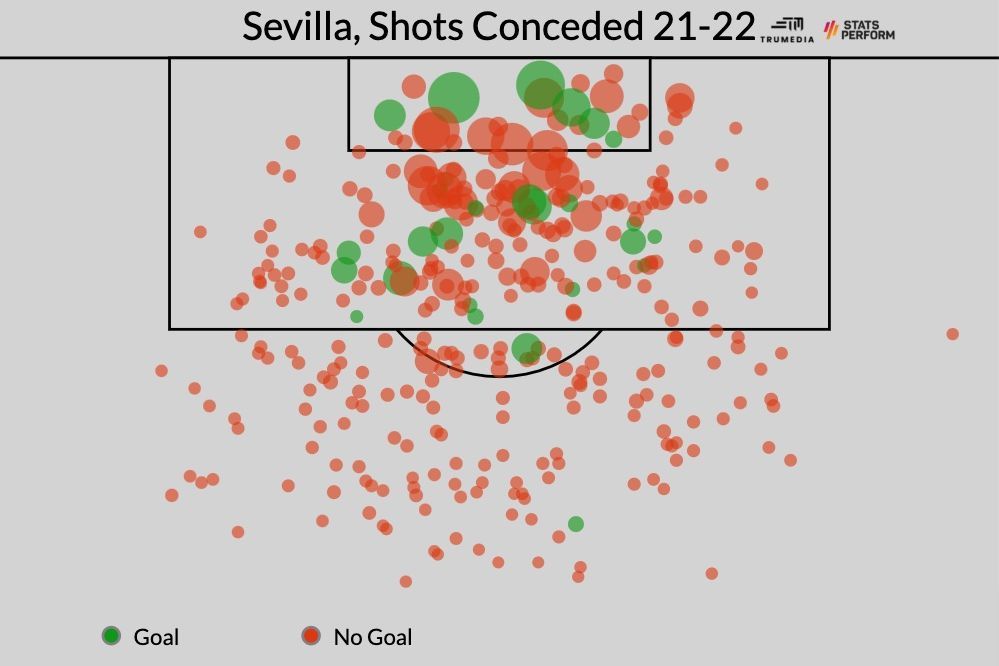
Real Madrid are like Sevilla… only better. They have a plus-27 goal differential from an xG differential of plus-16.12 — essentially the difference between a true Champions League contender and a dark horse with an outside shot. Despite red-hot finishing seasons from Karim Benzema and Vinicius Junior, most of Madrid’s good fortune has come without the ball: 18 goals allowed from 25.99 xG. Their opponents have completely missed the target from a number of big chances:

Chelsea are like Real Madrid… only better. They have a plus-29 goal differential from an xG differential of plus-18.05. That’s essentially the difference between being one of the three best teams in the world, and being in the tier just outside of it. (Liverpool, Bayern Munich, and Manchester City all have xG differentials of plus-32 or better; no other team is north of plus-26.) Of course, the narrative here has already run its course: when Chelsea were sitting in first and matching results with Liverpool and City over the opening months of the season, it never really seemed like they had the staying power. Sure enough, they’re now 10 points back of City.
Perhaps that’s a preview of what we’re about to see happen in Italy. While it seems like we might be set for an intra-city title race with AC Milan and Inter Milan separated by just one point, the Rossoneri have been running red-hot. They’ve produced a goal-differential of plus-23 from an xG differential of plus-10.31. While the Nerazzurri also seem set for some regression — mainly on the defensive end, where they’ve conceded 16 goals from 22.38 xG — they’re just playing at a higher level than the team with which they share a stadium. It’s clear in their third-best-in-Europe goal differential (plus-35, from one fewer game) and their fourth-best-in-Europe xG number (plus-25.89).
Teams Likely to Improve
Most of the teams with the largest difference between their actual goal-scoring numbers and their underlying stats are simply just bad teams. Greuther Furth, Norwich City and Salernitana are all at least 14 goals worse than expected, but they’re all also in the bottom five of xG differential. Being terrible and unlucky is the simplest recipe for relegation, and all three are sitting last in their respective leagues.
(While we’re here: Newcastle United have the worst xG differential, minus-21.46, across the Big Five leagues. Yikes.)
Last season, Lille won Ligue 1 thanks to an incredible 38-game run that saw them convert 51.51 xG into 64 goals and their opponents flip 31.66 xG into just 23 scores. It’s incredible… and unsustainable. This season, they’ve turned an xG differential of plus-12.54 into an even goal differential. Not plus, not minus; just zero. The defending champs are currently in 10th, but only PSG have a better xG differential in Ligue 1 so far. Look for them to make a charge up the table over the second half of the season.
The same goes for Barcelona in LaLiga. You probably don’t need numbers to tell you that the talent collected in the Camp Nou should result in something better than “sixth place in Spain.” They have the best xG differential in La Liga (plus-16.79), but just the fifth-best goal differential (plus-8). To be clear, this team is nowhere near the levels that we’re used to seeing Barca reach. They have the seventh-best xG differential in Europe, and Dani Alves and Luuk De Jong are not only starting for the club — they’re linking up to create the only goal they score in a 1-1 draw with Granada. But when you have the resources of Barcelona, things can only get so bad.
While Barca got smashed by Bayern Munich both times they played each other, 12th-place Borussia Monchengladbach now have two wins and a draw from their last three matches against the nine-time defending Bundesliga champs. Monchengladbach’s performance against arguably the best team in the world — eight goals for, two against — suggests that they’re better than their record. And so do their underlying numbers: a minus-9 goal differential from a plus-1.00 xG differential.
Players Likely to Decline
Expected goals is an aggregate number. Over time, most teams and players will play toward that number, but like with any aggregate number, there will be outliers on both sides.
Across the 382 games Diego Simeone has managed at Atletico Madrid, his team has exceeded its expected goal differential by 112 goals. There was clearly just something about the way Simeone got his teams to play that fooled the models… but not this year. Jan Oblak can’t save anything, and their xG differential is better than their actual goal differential.
Instead, Simeone’s son, Verona striker Giovanni Simeone, has stolen all of the magic. The 26-year-old has scored 12 non-penalty goals from 5.26 xG — the largest gap in Europe. And just for good measure, he’s banked three assists from 0.7 expected assists. Little Simeone has converted almost every decent opportunity into a goal, something that’s unlikely to continue across the second half of the season:
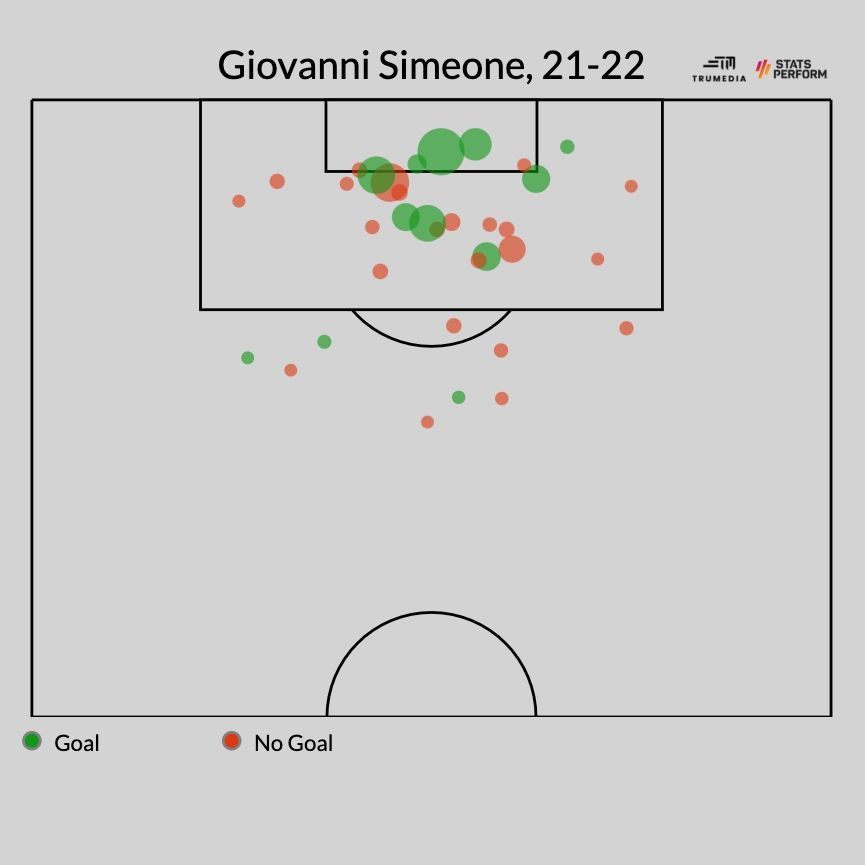
The only other player to exceed his xG by at least six goals is Patrick Schick, who’s got 16 non-penalty goals from 9.91 expected. Per FBref, he’s scored with 33 percent of his shots, while the Bundesliga average this season is 11 percent. Among players to attempt at least 30 shots this season, no one’s converted at a higher clip. Schick has only played 15 games and he’s already scored more goals than he ever has in a domestic season.
In the Premier League, Arsenal‘s Emile Smith Rowe has scored with 32 percent of his shots, flipping 3.96 xG into eight goals. Unless he’s the greatest kicker of the soccer ball the world has ever seen — twice as good as the average player — that’s just not going to continue.
Reported Arsenal target, Fiorentina striker Dusan Vlahovic, is also riding a similar hot streak. His goal-scoring numbers are inflated by five penalties — tied for the second-most in Europe — and some potentially unsustainable finishing: 11 non-penalty goals from 7.08 xG. He just doesn’t get many high-quality shots.
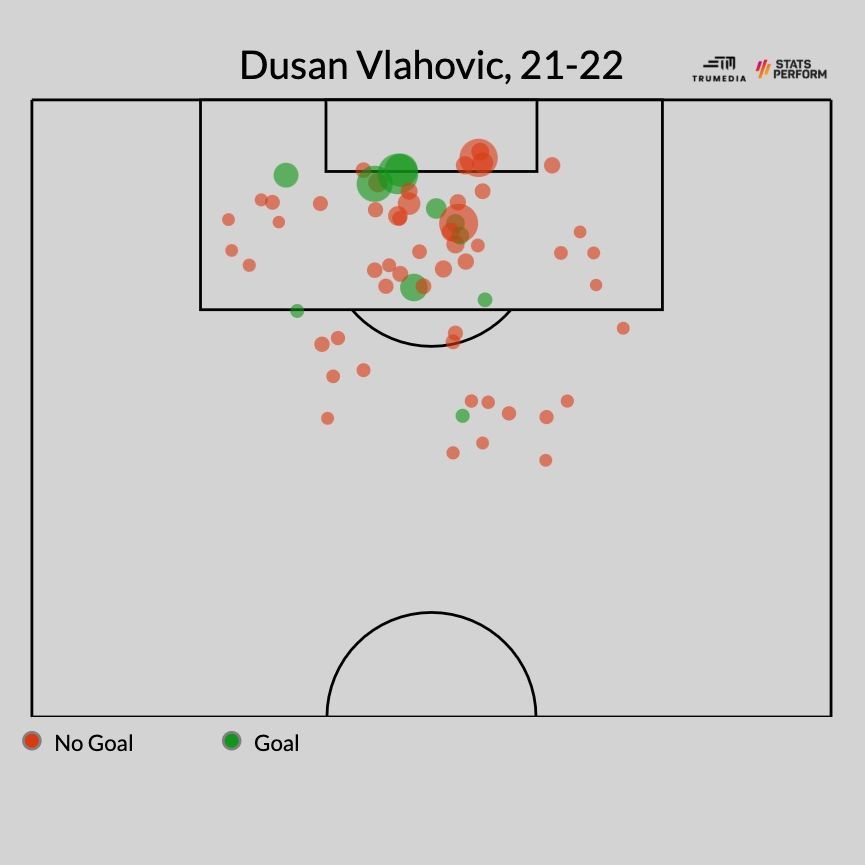
At only 21 years old, Vlahovic would be an acquisition for the future, but whoever signs him will likely be paying a premium for a present that’s not quite as good as it looks.
Players Likely to Improve
Since the advent of expected goals around the beginning of the previous decade, just a handful of players have outscored their underlying numbers consistently enough for any data analyst to confidently consider them “great finishers.” At the top, it was Lionel Messi, and then somewhere in the immediate tier below, there was Harry Kane. So if this doesn’t convince you that you shouldn’t draw too many conclusions about a team or player’s ability to convert shots into goals from just half a season, I don’t know what will.
Kane has scored three non-penalty goals from 6.26 xG — the second-biggest negative gap in the Premier League, behind Wolverhampton’s Trincao. He’s just not going to keep missing all of these massive chances inside and on the edge of the six-yard box. Consider it another reason to be bullish on Tottenham’s chances of finishing in the top four.
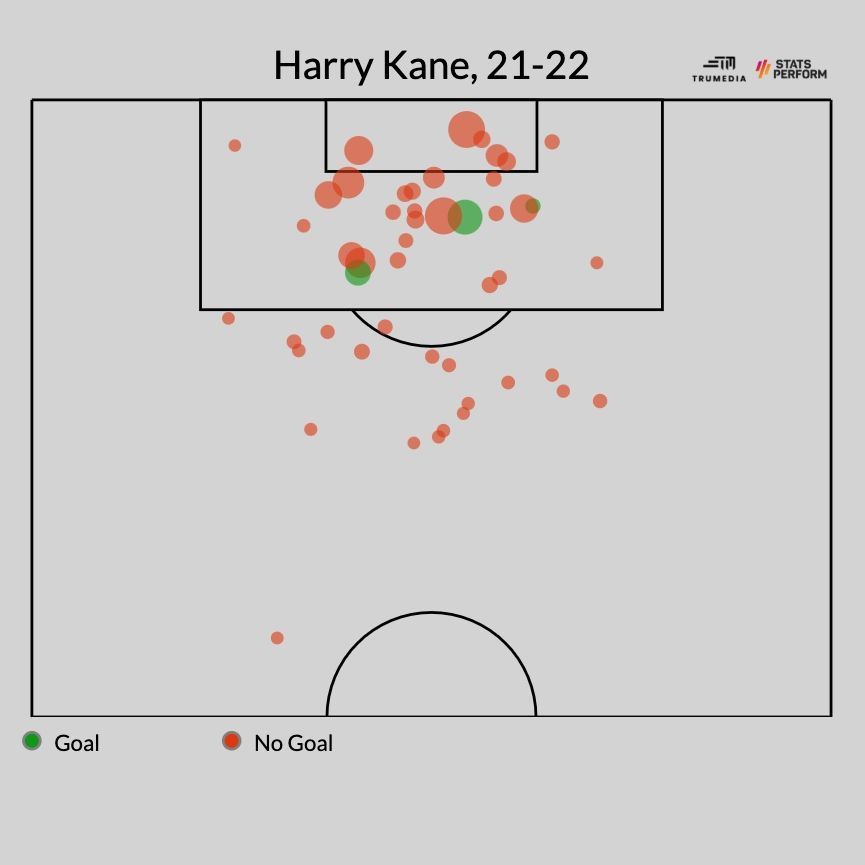
But Kane looks like Messi, compared to… Messi. The six-time Ballon d’Or winner has scored one goal from 4.90 xG — a worse return than all but three players across Europe.
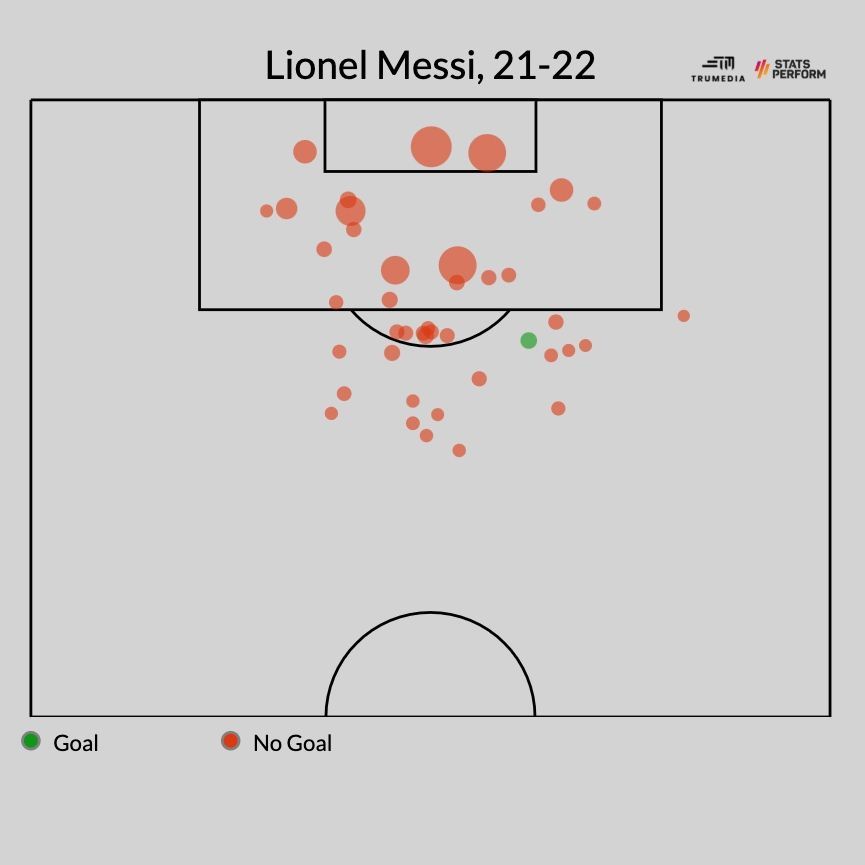
Even with this season’s cold streak, Messi has scored 335 non-penalty goals on 263.19 xG since 2010. That’s a gap of 71.81, while no one else is north of 35 over that same stretch.
What does that tell you? Well, sometimes the best finisher of the modern era just happens to miss a bunch of shots in a row. Remember that the next time another great player goes a couple weeks without scoring a goal.
Credit: Source link